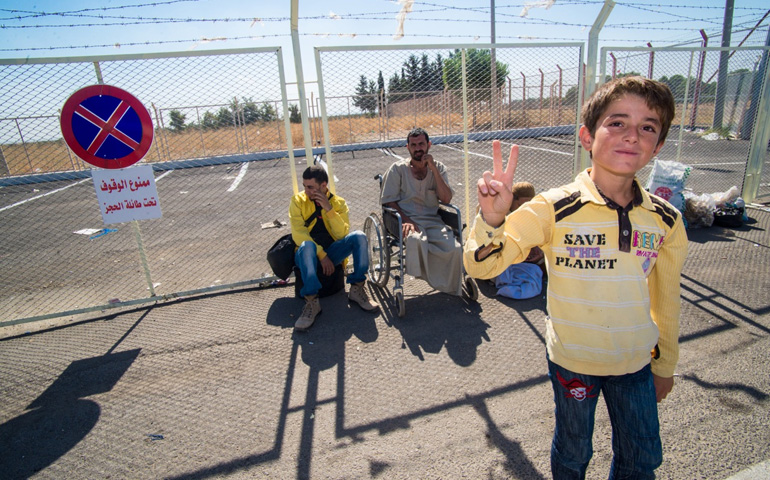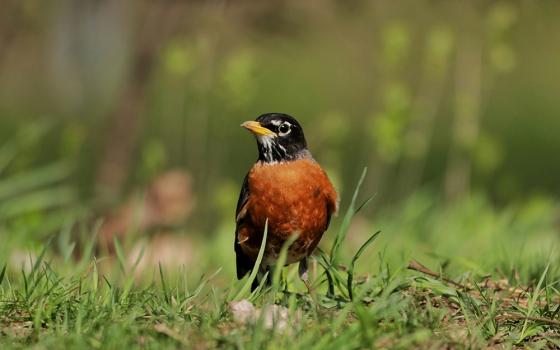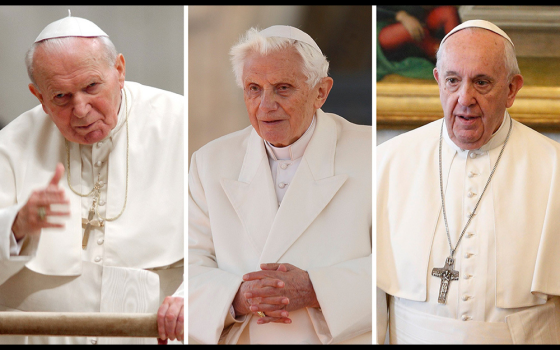
A Syrian refugee boy flashes a peace sign along the border in Kilis, Turkey, in mid-September. (CNS/The Catholic Register/Michael Swan)
Fifteen-year-old Abdullah Haji Mustafa wants to fight. He has been living in a refugee camp in Turkey for a year, since his family fled Tall Rifat, an embattled Syrian town just north of Aleppo.
"Who wants not to go back?" he asks, standing between the gates of the camp and a steady stream of refugees passing through the Turkish border control. "I want to be a fighter. I will go to make freedom."
Asked whether he really thinks fighting can bring peace, he responded: "I want peace. A soldier is the maker of peace."
Abdullah is one of more than a million Syrian children living as refugees outside of Syria. He's not alone in Kilis; there are children everywhere. Kids offer to help refugees with their bags, wait for relatives to return from trips back into Syria or try to sell fruit to travelers passing by.
Children make up about half of the Syrian refugee population. There are about 740,000 refugees under the age of 11. The U.N. High Commissioner for Refugees reports significant numbers of unaccompanied Syrian children crossing the borders with Iraq, Jordan, Lebanon and Turkey. At least 7,000 Syrian children are among the 100,000 casualties of the 32-month-old civil war.
Abdullah's town was under siege by Syrian security forces in 2011. In 2012, a council of Islamic scholars and former Syrian army officers took over administration of the town, ruling by Islamic law. As the Syrian army has pushed to retake Aleppo, it has bombed Tall Rifat from the air, hitting civilian targets.
In the Kilis refugee camp, Abdullah goes to school, studying the Syrian curriculum in Arabic with a class in Turkish language added. The Syrian teachers who run the camp school have modified the civics classes to avoid a heroic portrait of the family of President Bashar Assad, which was part of the curriculum inside Syria.
Abdullah's bravado is not shared by all Syrian children. Eleven-year-old Mohamad Zarzar is a survivor of the battle of Idlib in northern Syria.
"I don't want to return. Not in this situation," said the boy as he hung around a center that offers meals, showers and counseling for Kilis' growing refugee population.
The battle over Idlib raged for months from 2011 through 2012. At one point the London-based Syrian Observatory for Human Rights reported that Syrian army forces were randomly shelling the city and had killed 14 civilians in the course of retaking it in April 2012. As recently as Sept. 15 the observatory reported three more dead.
But children on the Turkish side of the border are relatively lucky. They have some form of school, whether they are in the camps or in town.
"The Turkish government will not allow Syrian kids to wander around the streets, that's for sure," said Philippe Zarif, head of Turkish operations for the Jesuit Refugee Service. "Inside the refugee camps managed by the Turkish government, schools are running."
On the other side of the border it's a completely different picture. Children stuck in makeshift refugee camps in Syria have no hope of school or any other program.
"Kids are not doing anything," said Zarif. "There's minor work done by NGOs in areas close to the border ... other than that, you have millions of kids in Syria doing nothing."

